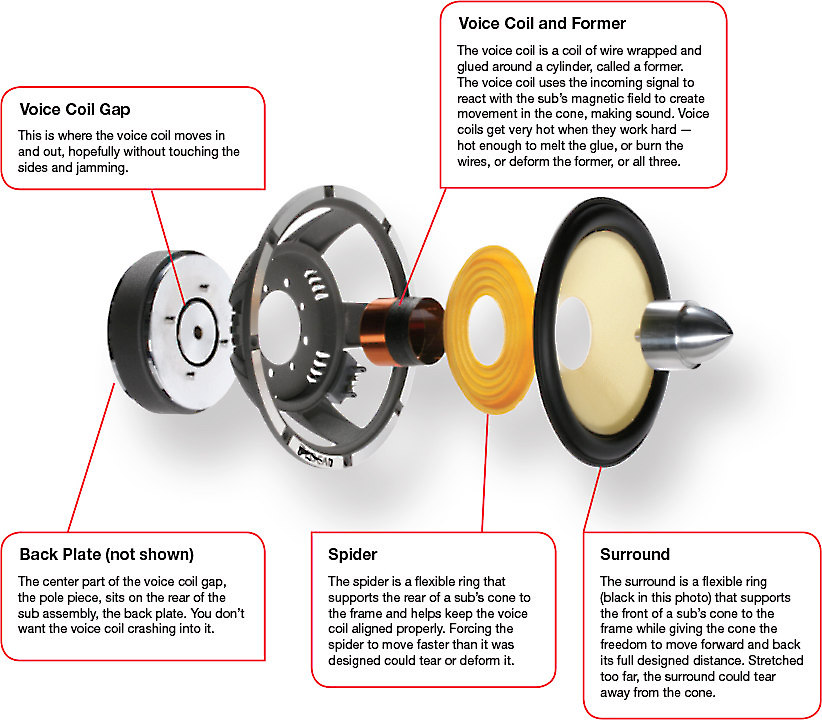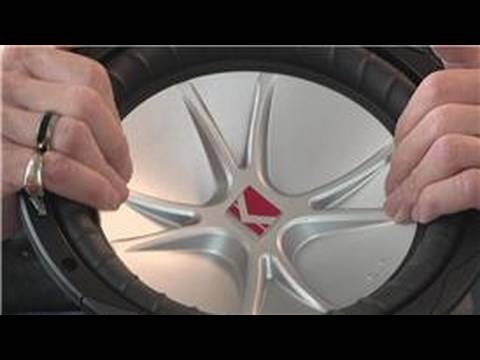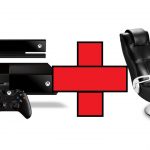To tell if a subwoofer is blown, listen for a lack of bass and distorted sound. Determining if your subwoofer is blown is essential for maintaining optimal audio performance in your sound system.
A blown subwoofer can result in a significant decrease in bass output and may produce distorted or crackling sounds during playback. By paying attention to these potential signs, you can quickly assess the condition of your subwoofer and take appropriate steps to address any issues that may arise.
We will explore some key indicators that can help you identify if your subwoofer is blown, as well as provide tips on how to troubleshoot and potentially resolve the problem.
Signs Of A Blown Subwoofer
Identifying whether a subwoofer is blown can be crucial in ensuring the optimal performance of your audio system. Below are the key signs to look out for when determining if a subwoofer is blown.
No Sound
Lack of any audio output from the subwoofer when the system is playing may indicate a blown subwoofer. Ensure the device is properly connected and the volume levels are appropriate before considering further diagnostics.
Distorted Sound
If the sound produced by the subwoofer is garbled or distorted, it could signify a problem with the speaker. Distorted sound may indicate a damaged cone or voice coil within the subwoofer.

Credit: www.reddit.com
Physical Inspection
When checking if a subwoofer is blown, starting with a physical inspection can provide valuable insights.
Visible Damage
- Look for physical signs of damage such as cracks or tears in the subwoofer cone.
- Inspect for any obvious wear and tear that may indicate a problem.
Loose Connections
- Make sure all connections to the subwoofer are securely fastened.
- Check for any loose wires that could be causing issues.
Listening Test
When determining if a subwoofer is blown, conducting a listening test is a simple yet effective way to diagnose any issues with your subwoofer. Below, we will detail two key signs to listen for during this test: rattling or vibrating sound and lack of bass.
Rattling Or Vibrating Sound
- Listen for any strange noises, such as buzzing or rattling, especially during low frequencies.
- Check if the rattling or vibrating sound persists across different audio files or sources.
- Pay attention to the timing of the sound – does it occur consistently or sporadically?
Lack Of Bass
- Assess if the subwoofer is producing deep, rich bass or if the sound feels weak.
- Compare the bass output to how it originally performed to identify any discrepancies.
- Check if there is clipping in the bass frequencies, which can indicate a blown subwoofer.

Credit: www.crutchfield.com
Checking Amplifier
When it comes to checking if your subwoofer is blown, one of the crucial steps is to inspect the amplifier. The amplifier plays a pivotal role in powering the subwoofer, and any issues with it can lead to subpar performance or complete failure. Here’s how you can troubleshoot the amplifier to determine if it’s causing the problem.
Amplifier Troubleshooting
Start by examining the amplifier for any visible signs of damage, such as burnt components or a strong odor of burnt electrical components. Inspect the wiring connections to ensure they are secure and free from any corrosion or damage. Additionally, check the fuse for the amplifier to see if it’s intact or blown. A blown fuse is often a clear indicator of an underlying issue.
Testing With Another Subwoofer
If you’ve gone through the above steps and the amplifier appears to be in good condition, it’s beneficial to test it with another subwoofer. Disconnect the existing subwoofer and connect a known working subwoofer to the amplifier. If the new subwoofer functions properly, it’s likely that the original subwoofer is the culprit. However, if the problem persists with the new subwoofer, the issue may lie in the amplifier itself, and you may need to seek professional assistance.
Using A Multimeter
Troubleshooting audio equipment issues can be tricky, but by using a multimeter, you can easily determine if your subwoofer is blown. A multimeter is a handy tool that can measure electrical properties such as continuity and impedance. In this section, we will guide you through the process of determining if your subwoofer is blown using a multimeter.
Checking Continuity
Checking continuity is an essential step when trying to identify if your subwoofer is blown. Continuity refers to the uninterrupted flow of electrical current through a circuit. If there is a break in the circuit, it indicates that there is likely a blown component. To check continuity:
- Set your multimeter to the continuity or resistance setting (Ω).
- Detach the subwoofer from the amplifier or receiver.
- Touch the multimeter probes to the positive and negative terminals of the subwoofer.
- Observe the multimeter’s reading. If it shows a value close to zero or beeps, it means there is continuity, indicating that the subwoofer is not blown. However, if the reading is infinite or there is no beep, it suggests a break in the circuit, indicating a blown subwoofer.
Measuring Impedance
Measuring impedance is another method to determine if your subwoofer is blown. Impedance refers to the resistance to the flow of electrical current in a circuit. A blown subwoofer typically exhibits a significant deviation in impedance. To measure impedance:
- Set your multimeter to the impedance setting (Ω).
- Detach the subwoofer from the amplifier or receiver.
- Identify the nominal impedance rating of your subwoofer. It is usually written on the back or in the user manual.
- Touch the multimeter probes to the positive and negative terminals of the subwoofer.
- Read the multimeter’s value. If it matches the nominal impedance rating of your subwoofer, it indicates that the subwoofer is not blown. However, if the reading deviates significantly, it suggests a blown subwoofer.
Using a multimeter is an effective way to determine if your subwoofer is blown. By checking continuity and measuring impedance, you can easily identify any issues in the subwoofer’s circuit. If you find that your subwoofer is indeed blown, it may be time for a replacement or professional repair.
Professional Inspection
When it comes to evaluating the state of your subwoofer, sometimes it’s best to leave it to the professionals. A professional inspection conducted by an audio technician can provide you with accurate information about the condition of your subwoofer and help you determine if it is indeed blown. This is especially useful if you are unsure of what signs to look for or if you have already tried some troubleshooting techniques without success.
Consulting An Audio Technician
Consulting an audio technician is the first step towards finding out if your subwoofer is blown. These experts have the knowledge and experience to assess the condition of your subwoofer and identify any issues that may be affecting its performance. They can use specialized equipment and conduct various tests to determine the specific problem.
During a professional inspection, the audio technician may perform tests such as:
- Visually inspecting the subwoofer for any visible damage or abnormalities.
- Using a multimeter to check the continuity of the subwoofer’s voice coil and other electrical connections.
- Listening to the subwoofer to identify any unusual sounds or vibrations.
- Conducting an impedance test to measure the resistance of the subwoofer.
Based on their findings, the audio technician can provide you with a detailed report and recommendations on the next steps to take.
Repair Or Replacement
Once the audio technician has inspected your subwoofer, they can advise you on whether it’s worth repairing or if replacement is the better option. If the damage is minor and can be fixed without incurring significant costs, they may suggest repairing the subwoofer. This could involve replacing certain components or repairing the wiring.
On the other hand, if the subwoofer is severely damaged or if the cost of repairs is close to or exceeds the price of a new subwoofer, the audio technician may recommend replacing it altogether. They can help you explore different options based on your budget and audio preferences.
Remember, a professional inspection is the most reliable way to determine if your subwoofer is blown. By consulting an audio technician and following their expert advice, you can ensure that your subwoofer is up and running in no time.
Preventing Subwoofer Damage
Proper maintenance and care can prevent subwoofer damage, ensuring optimal performance and longevity.
Proper Power Handling
Subwoofers should be powered with an amplifier that matches their power handling capabilities. Refer to the subwoofer’s manual or specifications for the recommended power range. Exceeding the power limits can lead to blown subwoofers.
Avoiding Overdriving
Overdriving the subwoofer with a distorted or clipped audio signal can cause damage. Always adjust the volume and settings to avoid overdriving the subwoofer, ensuring a clean audio signal for optimal performance.
Maintenance And Care
Learn to identify signs of a blown subwoofer by checking for distorted sound or lack of bass. Regular maintenance and care can help prevent such issues. Inspect connections and speaker components regularly to ensure optimal performance.
Cleaning Regularly
Regular cleaning is essential for extending the lifespan of your subwoofer. Make sure to wipe dust and dirt off the subwoofer cabinet regularly. Use a soft cloth or a gentle brush to clean hard-to-reach areas effectively.Protecting From Moisture
Keep your subwoofer away from areas prone to moisture. Use a dehumidifier in damp spaces to prevent damage. Consider using a waterproof cover for outdoor installations of the subwoofer.
Credit: m.youtube.com
Conclusion
Being able to identify whether a subwoofer is blown is crucial for maintaining the quality of your sound system. By following the steps outlined you can assess the condition of your subwoofer and take appropriate action to repair or replace it.
Ensuring your subwoofer is in good working order will enhance your overall audio experience.









